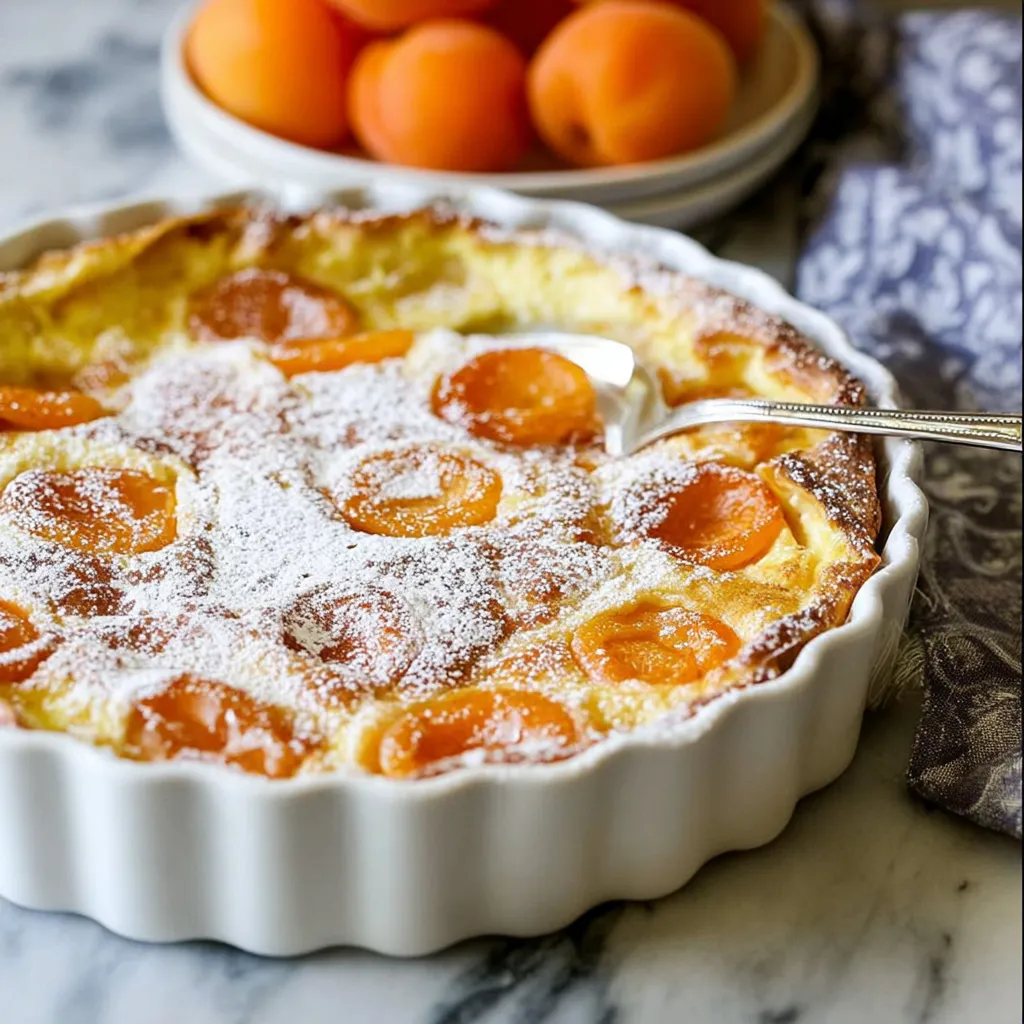 Save
Save
This rustic Apricot Flaugnarde transforms fresh apricots into a delightful French dessert that bridges the gap between pancake and custard. The whiskey adds a subtle warmth while the custardy batter puffs beautifully around the fruit for an impressive yet simple dessert.
I discovered flaugnarde during a summer in Provence and have been making this version ever since. My guests always assume it's complicated but are shocked when I reveal how simple it actually is to prepare.
Ingredients
- Fresh apricots: Bring sweet tanginess and become jammy when baked
- Whole milk and heavy cream: Create the rich custard base
- Rye whiskey: Adds complexity and warmth without tasting boozy
- Pure vanilla extract: Enhances the natural sweetness of the fruit
- All purpose flour: Provides structure while keeping the texture tender
- Eggs: Bind everything together and help create the signature puff
- Sugar: Sweetens just enough without overwhelming the fruit
- Salt: Balances the sweetness and enhances flavors
- Powdered sugar: For the final dusting adds visual appeal and extra sweetness
Step-by-Step Instructions
- Prepare the Baking Dish:
- Thoroughly butter a 10 inch round quiche dish or pie plate ensuring all sides are well coated to prevent sticking. The butter will also add a wonderful richness to the edges of the flaugnarde.
- Arrange the Apricots:
- Place halved apricots in a circular pattern with cut sides facing up in the buttered dish. Arranging them thoughtfully creates a beautiful pattern that will be visible in the finished dessert.
- Create the Batter:
- Whisk milk, heavy cream, vanilla, whiskey, and eggs together until completely combined. The liquid ingredients need to be fully incorporated before adding dry ingredients. Add salt and flour, whisking vigorously to eliminate any lumps for a smooth, silky batter.
- Assemble and Bake:
- Pour the batter carefully around the arranged apricots, avoiding disturbing their placement. Place in preheated 375°F oven and bake for 30 to 35 minutes until the edges are golden and the center is puffed. The flaugnarde will rise dramatically during baking.
- Finish and Serve:
- Allow to cool to room temperature which allows the custard to set properly. Just before serving, dust generously with powdered sugar which melts slightly into the warm dessert creating a beautiful finish.

Rye whiskey might seem like an unusual addition but it complements the apricots beautifully by enhancing their natural sweetness. The first time I served this at a dinner party my friend's elderly mother who claimed to never touch alcohol had three slices before I mentioned the secret ingredient.
The Science Behind the Puff
The dramatic rise of a flaugnarde comes from the eggs in the batter. When heated, the proteins in the eggs expand and create air pockets throughout the mixture. As the flaugnarde cools it will deflate slightly which is completely normal. For maximum height serve shortly after baking but for the best flavor and texture allow it to cool slightly.
Seasonal Adaptations
Flaugnarde traditionally showcases whatever fruit is in season. In spring try rhubarb with a touch more sugar. Summer brings endless possibilities with berries, peaches, or plums. Fall versions work beautifully with pears or apples though these firmer fruits benefit from a quick sauté in butter first. Winter flaugnardes can feature poached quince or even dried fruits soaked in brandy or rum.
Serving Suggestions
While delicious on its own, this flaugnarde pairs wonderfully with various accompaniments. A dollop of lightly whipped cream adds richness while a scoop of vanilla ice cream creates a hot and cold contrast. For breakfast or brunch serve it with a spoonful of tangy yogurt. If serving as dessert, a small glass of dessert wine particularly Sauternes complements the apricot flavors beautifully.
Cultural Context
Flaugnarde comes from the Limousin region of France and is closely related to clafoutis. Traditionally clafoutis specifically refers to a cherry version while flaugnarde encompasses all other fruits. This humble country dessert was created to showcase seasonal fruits in a simple preparation that could be made with pantry staples. The name comes from the Occitan word "flaunhard" meaning soft or downy referring to its delicate texture.
Recipe FAQs
- → What is the difference between a flaugnarde and a clafoutis?
A flaugnarde and clafoutis are essentially the same dessert with different names based on the fruit used. Traditionally, a clafoutis specifically refers to the dessert made with cherries, while a flaugnarde is made with fruits other than cherries, such as apricots, peaches, pears, or plums.
- → Can I substitute the rye whiskey with something else?
Yes, you can substitute the rye whiskey with bourbon, brandy, or rum for a different flavor profile. For a non-alcoholic version, try using apple juice, orange juice, or simply increase the vanilla extract to 1 teaspoon.
- → Can I make this dessert ahead of time?
Yes, you can prepare this flaugnarde up to a day in advance. Store it covered in the refrigerator and bring to room temperature before serving. Add the powdered sugar dusting just before serving for the best presentation.
- → What can I use if fresh apricots aren't available?
If fresh apricots aren't in season, you can substitute with other stone fruits like peaches, nectarines, or plums. You could also use drained canned apricots in a pinch, though the texture and flavor will be slightly different from fresh fruit.
- → Why did my flaugnarde collapse after baking?
This is completely normal! A flaugnarde will puff up beautifully during baking but naturally deflates as it cools. This dessert is meant to be served flat rather than puffed, and the slight deflation creates its characteristic custardy texture.
- → Can I use a different type of flour in this recipe?
While all-purpose flour works best for the classic texture, you can experiment with alternatives. Try substituting up to half the flour with almond flour for a nuttier flavor, or use gluten-free all-purpose flour blend if needed for dietary restrictions.
